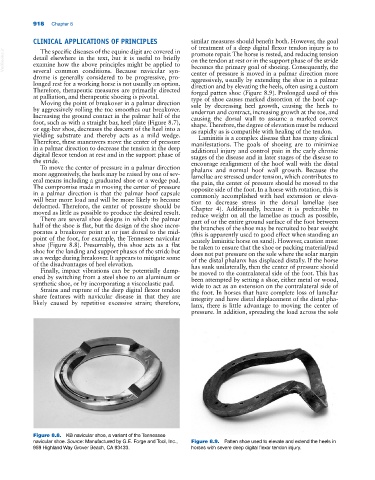Page 952 - Adams and Stashak's Lameness in Horses, 7th Edition
P. 952
918 Chapter 8
CLINICAL APPLICATIONS OF PRINCIPLES similar measures should benefit both. However, the goal
of treatment of a deep digital flexor tendon injury is to
The specific diseases of the equine digit are covered in
VetBooks.ir detail elsewhere in the text, but it is useful to briefly on the tendon at rest or in the support phase of the stride
promote repair. The horse is rested, and reducing tension
examine how the above principles might be applied to
becomes the primary goal of shoeing. Consequently, the
several common conditions. Because navicular syn-
drome is generally considered to be progressive, pro- center of pressure is moved in a palmar direction more
aggressively, usually by extending the shoe in a palmar
longed rest for a working horse is not usually an option. direction and by elevating the heels, often using a custom
Therefore, therapeutic measures are primarily directed forged patten shoe (Figure 8.9). Prolonged used of this
at palliation, and therapeutic shoeing is pivotal. type of shoe causes marked distortion of the hoof cap-
Moving the point of breakover in a palmar direction sule by decreasing heel growth, causing the heels to
by aggressively rolling the toe smoothes out breakover. underrun and contract, increasing growth at the toe, and
Increasing the ground contact in the palmar half of the causing the dorsal wall to assume a marked convex
foot, such as with a straight bar, heel plate (Figure 8.7), shape. Therefore, the degree of elevation must be reduced
or egg‐bar shoe, decreases the descent of the heel into a as rapidly as is compatible with healing of the tendon.
yielding substrate and thereby acts as a mild wedge. Laminitis is a complex disease that has many clinical
Therefore, these maneuvers move the center of pressure manifestations. The goals of shoeing are to minimize
in a palmar direction to decrease the tension in the deep additional injury and control pain in the early chronic
digital flexor tendon at rest and in the support phase of stages of the disease and in later stages of the disease to
the stride. encourage realignment of the hoof wall with the distal
To move the center of pressure in a palmar direction phalanx and normal hoof wall growth. Because the
more aggressively, the heels may be raised by one of sev- lamellae are stressed under tension, which contributes to
eral means including a graduated shoe or a wedge pad. the pain, the center of pressure should be moved to the
The compromise made in moving the center of pressure opposite side of the foot. In a horse with rotation, this is
in a palmar direction is that the palmar hoof capsule commonly accomplished with heel extension or eleva-
will bear more load and will be more likely to become tion to decrease stress in the dorsal lamellae (see
deformed. Therefore, the center of pressure should be Chapter 4). Additionally, because it is preferable to
moved as little as possible to produce the desired result. reduce weight on all the lamellae as much as possible,
There are several shoe designs in which the palmar part of or the entire ground surface of the foot between
half of the shoe is flat, but the design of the shoe incor- the branches of the shoe may be recruited to bear weight
porates a breakover point at or just dorsal to the mid- (this is apparently used to good effect when standing an
point of the foot, for example, the Tennessee navicular acutely laminitic horse on sand). However, caution must
shoe (Figure 8.8). Presumably, this shoe acts as a flat be taken to ensure that the shoe or packing material/pad
shoe for the landing and support phases of the stride but does not put pressure on the sole where the solar margin
as a wedge during breakover. It appears to mitigate some of the distal phalanx has displaced distally. If the horse
of the disadvantages of heel elevation. has sunk unilaterally, then the center of pressure should
Finally, impact vibrations can be potentially damp- be moved to the contralateral side of the foot. This has
ened by switching from a steel shoe to an aluminum or been attempted by setting a shoe, either metal or wood,
synthetic shoe, or by incorporating a viscoelastic pad. wide to act as an extension on the contralateral side of
Strains and rupture of the deep digital flexor tendon the foot. In horses that have complete loss of lamellar
share features with navicular disease in that they are integrity and have distal displacement of the distal pha-
likely caused by repetitive excessive strain; therefore, lanx, there is little advantage to moving the center of
pressure. In addition, spreading the load across the sole
Figure 8.8. KB navicular shoe, a variant of the Tennessee
navicular shoe. Source: Manufactured by G.E. Forge and Tool, Inc., Figure 8.9. Patten shoe used to elevate and extend the heels in
959 Highland Way Grover Beach, CA 93433. horses with severe deep digital flexor tendon injury.

